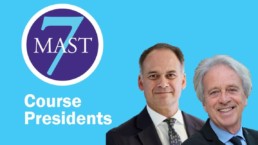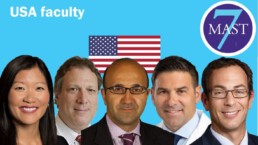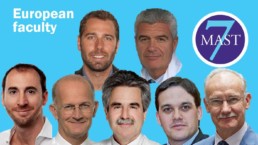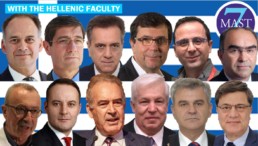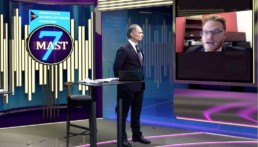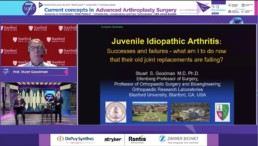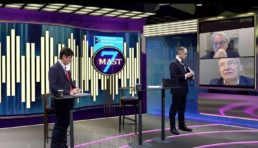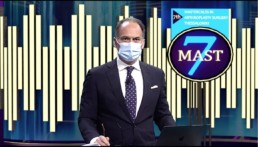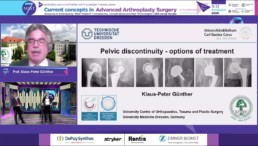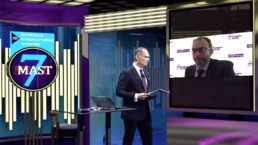Friday 11th December
The e-Conference was launched with an excellent introduction by the EHS President, Dr Jean Alain Epinette, who praised the long standing success of the MAST Course and the collaboration with EHS, which has been successful for the last 7 years. The MAST President and Host, Prof Eleftherios Tsiridis, introduced the 3-day programme and satellite lectures, and described the new concept of the virtual studio, introducing the co-anchor man, Prof Theofilos Karachalios.
The first satellite lecture was given by Dr Christof Berberich, a very interesting approach regarding the antibiotic protection against the periprosthetic joint infection. Dr Berberich with a long standing experience as a microbiologist, supported the view that antibiotic impregnated cement can protect against infection in a primary or a revision setting.
The highlight of the day was the subsequent satellite symposium on TKA new designs and bearing surfaces in relation to ROSA Robotics. Prof Tsiridis introduced the current concept of soft tissue balancing and stability, as well as the newer concept of kinematic alignment. Thereafter, Prof Francesco Binazzo introduced the Persona® Knee tibial plateau and bearing design, as well as the function of ROSA® Robotic Arm, with an amazing video presentation of the whole technique. Thereafter Professors Tsiridis and Benazzo had an interactive discussion deploying the forthcoming advantages of robotic surgery and their vision to expand the use of robotics in arthroplasty surgery.
The programme continued with 3 distinguished lectures and case presentations by Professor Panagiotis Megas, presenting the reconstruction of acetabular defects using tantalum augments and bone graft, Prof George Babis presented a wonderful video of a high DDH THA with shortening osteotomy and Dr Vasilios Bitounis presented a post traumatic complex TKA needing re-revision.
The programme continued with an excellent key note presentation by Prof Konstantinos Malizos regarding the diagnosis and management of infected versus non infected hip revisions with particular interest in Alval mimicking infection.
The programme continues with the USA perspectives. Prof Javad Parvizi and Dr Maxwell Courtney gave us the current perspectives on diagnosis and management of periprosthetic joint infection. They presented the next generation sequencing technique and they discussed briefly the one versus two stage revision.
Prof Craig Della Valle gave us a wonderful presentation of his published algorithm for the management of the unstable hip. He presented the 5 different classes of instability and revisited the constrained liners, comparing them with dual mobility sockets.
Prof Antonia Chen from Harvard gave us a thorough review on robotic technology in total joint arthroplasty. She has published extensively on this field and gave us a balanced overview of the promising early results versus steep learning curve, high cost and big footprint of the existing systems.
Prof Ran Schwarzkopf – after he received Prof Tsiridis’ congratulations for his very recent promotion to the professorial rank at NYU – presented a very thorough comparison between the mini anterior and the mini posterior approach for the hip. He told us that there is some recent concern about certain complications related to the anterior approach and concluded that there is no difference in the outcome between the two. He presented his personal approach to this issue, saying that he prefers the mini posterior approach in his practice, as this can be used for any patient, any implant, any deformity, it is extensile for revision and has a very low learning curve.
Saturday 12th December
The congress started early in the morning with Prof Theofilos Karachalios presenting his approach on acetabular reconstruction in congenital hip disease treated with THA, followed by Dr George Macheras who presented his significant experience in femoral reconstruction and shortening osteotomies for DDH.
The time in California was 22:30 when we had the honour to have Prof Stuart Goodman from Stanford giving his keynote presentation on juvenile idiopathic arthritis and revision joint arthroplasty. He told us that he now prefers uncemented implants, whereas in the past he was treating these patients with cemented implants. He gave us an overview of complexities during the revision of these cases and presented a selection of his experiences, some of which are at some stage non reconstructable. His presentation was received with great enthusiasm from the audience, as this cohort remains very challenging for all of us.
Following this presentation, the European perspective group started on time. Prof Jean-Noël Argenson gave us a thorough overview between single versus two stage revision for infected TKA. He supported the one stage with specific protocols and he stressed the need for a multidisciplinary approach when dealing with these complex cases.
The President of EFORT, Prof Klaus Peter Gunther, presented an amazing overview of his experience on pelvic discontinuity and the treatment options. He told us that cage alone is not enough. He presented his technique using augment and cage, and he told us that acute discontinuity can be plated, while chronic is a different animal, and the cap-cage technique is best.
The EHS President, Dr Jean Alain Epinette, presented his huge experience on dual mobility from the last 20 years, especially for young individuals, and he presented the amazing cohort from the Orthowave and international arthroplasty registry he founded many years ago, that holds thousands of arthroplasty data. He told us that dual mobility is here to stay and it is an amazing solution not only for specific cases, but also for the highly demanding young patients.
Prof Wim Schreurs from Nijmegen in The Netherlands – the famous impaction grafting centre of excellence – presented his vast experience in this kind of surgery with amazing radiographs and follow-up of 25 years demonstrating complete bone reconstruction both in acetabular and femur. Prof Schreurs now leads the Dutch arthroplasty registry was in the position to tell us that impaction grafting is demanding, however, it is the best solution for the young.
Dr Oliver Marin-Peña presented arthroplasty registry data for the bearing couple in young THA patients. He told us that MoM has specific indications nowadays, CoC can be demanding and CoP is probably the best in the current literature.
Prof Justin Cobb from Imperial College London, with a vast experience in new technologies, robotics, resurfacing and uni-compartmental TKA from the MSK laboratory he runs, presented his new philosophy for TKA called “Compartmental Approach”. His vision is revolutionary and his promise for the future is very exciting.
Prof Sebastien Lustig from Lyon gave us his amazing paper on why revision TKA fails. The main reason he found in his enormous cohort of patients was infection, followed by loosening of the implants. He described a two stage revision technique and presented some amazing examples of the cases he has operated on recently.
The session ended with Dr Charles Riviere presenting the new concept of kinematic alignment in TKA. The new philosophy using the primary and the secondary femoral axis of a single cylinder crossing along the posterior femoral condyles and the acceptance of varos tibil cut and vulgas femoral cut to mimic their “physiological” knee joint.
Sunday 13th December
A full day of amazing surgical case presentations with live video surgery from the whole Hellenic faculty. Prof Panayiotis Papagelopoulos presented an amazing reconstruction using 3D printed prosthesis. Prof Karachalios presented his philosophy in individualised TKA. Dr Efstathios Kenanidis gave us 4 video surgeries of impressive re-revisions for failed TKAs and THAs, with a lot of surgical tips and tricks to approach and reconstruct the joints. Dr George Macheras gave an overview of treatment for periprosthetic femoral fractures in 2020. Prof George Drosos presented an infected periprosthetic femoral fracture that was treated with a 2-stage revision. Dr Lazaros Poultsides gave us an example of conversion arthrodesis to THA via an anterior approach. Prof Tsiridis presented several videos of complex hip and revision cases treated with custom made or modular revision implants, including the combination of partial bone replacement using tumour prosthesis.
Visit the MAST 7 website HERE
Testimonials
Congratulations on the high level provided by MAST 7
Prof Stanislav Bondarenko, EHS Nat Rep for Ukraine
A fantastic conference
Prof Antonia Chen, USA
The program was excellent and I must congratulate you for bringing together so many speakers from US and Europe – I learned a lot.
Klaus-Peter Gunther, President of EFORT
It was an excellent virtual meeting
Prof Theofilos Karachalios, EHS SciCom, Hellas
It was my pleasure to participate in your fantastic meeting that it is actually a “must” in the hip meetings calendar… Congrats for such a great success!!
Dr Oliver Marin-Pena, EHS Ambassador, Spain
MAST 7 was an excellent course, with such a great amount of outstanding orthopaedic surgeons and a high level of presentations and performed studies. The course was technically very well-organized: it was possible to see the moderators and presenting author and slides. It was one of the best virtually organized events. Many thanks for such awesome course
Prof Olga Pidgaiska, EHS Ambassador, Ukraine
MAST 7 was a great e-Conference. You guys did a great job!
Prof Ran Schwarzkopf, USA


